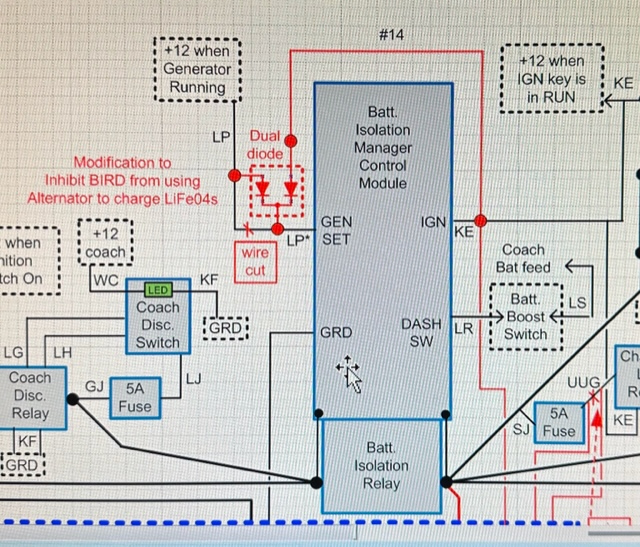Thought I'd share my project to upgrade to LiFe04 coach batteries.
I have a 960 Watt Solar system that can output up to 60 amps to the batteries in perfect conditions, a 3000 W PSW Inverter feeding entire coach thru a 30A transfer switch (converter charger is locked out when on inverter power), 4 2018 vintage 6V 200 AH golf cart batteries, Victron Battery Monitor w 500 A shunt.
Sharing because many don't realize that not just batteries get changed when you go to LiFe04 on a motorized RV, and because I figured out a way to avoid replacing the Precision Circuits Battery Isolator that Winnebago used on mine and a lot of other RVs.
When going to LiFe04 batteries:
You have to protect the alternator which involves preventing the chassis battery system from connecting to the coach battery system when ignition switch is in run. You add a ignition run enabled DC-DC charger that limits the alternator load and battery charge current to safe levels when RV is running. You change the Shore / Generator Powered converter-charger to one that is compatible with LiFe04 batteries. If you have a Battery Monitor and/or solar they need to be re-programmed to update the battery type and battery capacity.
I am doubling my usable storage so I can run a small portable air conditioner in my RV longer than I currently can now on just the GC batteries. Otherwise 2 Li batteries would be enough to replace 4 GC batteries.
My upgrade parts list:
4 100 AH Lithium batteries $ 1210 Replaces 4 GC Batteries
4 Group 27 battery boxes $ 64
Powermax PM4 Converter Charger $ 148 Replaces non-compatible unit
Renogy 40A DC-DC Charger $ 172
2 60A ANL Fuses w holders $ 18
Wire and supplies $ 40
Total without labor (includes KS sales tax) $ 1,652
Time to upgrade: 12 hours
1. Using 4 Lisuateli 12V 100 AH LiFe04 Batteries. Others had bench tested with good results so I took the risk of this supplier which was very attractive for price and features. I bench tested the ones I received and all were full 100 AH capacity and met proper voltage curves. I chose because it is very unusual for it's price point ( $ 278 ea. w shipping included ) to have an internal Battery Management System (BMS) that includes temperature protection to prevent battery from taking full charging current at very low temperatures - this can damage it. This manufacturer recommends use of up to a 20 amp per battery charge current and 14.4 to 14.6 volt charging voltage to maximize the battery life, so I designed my system accordingly.
I found Group 27 Battery Cases were a perfect fit for these batteries, to protect them.
2. As part of changing to LiFe04 I had to prevent the Coach - Chassis Battery Isolator Contactor from closing when the RV was running or I would have quickly driven my alternator to failure .
I figured out how to make a modification to the Precision Circuits Battery Isolation Manager (BIRD) so I would not have to replace it. The Generator Run input on the BIRD inhibits the Isolator Contactor from operating when the Ignition in Run input is also present. So I used a dual diode of same type used to double feed towed car tailamps to feed both Generator Run and Ignition in Run signals to the Generator Run input on the BIRD. Whenever Ignition in Run has signal the BIRD Isolator is now inhibited. With Ignition NOT in Run everything works same as before, the BIRD can continue to do its thing and keep the chassis battery charged if the BIRD senses it needs it.
3. I installed the Renogy 12V 40 Amp output DC to DC on-board battery charger to charge the coach batteries when driving. Renogy recommended the 40 Amp output model for the type of alternator in the Ford F53. Picked up chassis battery + and the ignition run signal at the BIRD. The DC to DC also has the advantage of taking whatever voltage the alternator is putting out and only putting out 14.6 volts which allows the LiFe04 batteries to fully charge to 100% from charging while driving.
4. Replaced my 100 A Converter Charger that was not designed for LiFe04 batteries with a 60 Amp PowerMax PM4, it is set-able and mine is set to charge LiFe04s.
5. Re-programmed my Solar Charge Controller for LiFe04.
6. Re-programmed my Victron Battery Monitoring System to LiFe04.

